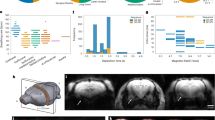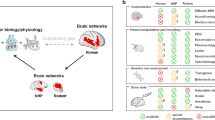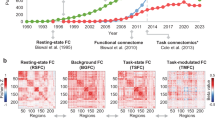Abstract
Templates for the acquisition of large datasets such as the Human Connectome Project guide the neuroimaging community to reproducible data acquisition and scientific rigor. By contrast, small animal neuroimaging often relies on laboratory-specific protocols, which limit cross-study comparisons. The establishment of broadly validated protocols may facilitate the acquisition of large datasets, which are essential for uncovering potentially small effects often seen in functional MRI (fMRI) studies. Here, we outline a procedure for the acquisition of fMRI datasets in rats and describe animal handling, MRI sequence parameters, data conversion, preprocessing, quality control and data analysis. The procedure is designed to be generalizable across laboratories, has been validated by using datasets across 20 research centers with different scanners and field strengths ranging from 4.7 to 17.2 T and can be used in studies in which it is useful to compare functional connectivity measures across an extensive range of datasets. The MRI procedure requires 1 h per rat to complete and can be carried out by users with limited expertise in rat handling, MRI and data processing.
Key points
-
The procedure covers all aspects of a typical neuroimaging experiment, thus enabling the use and comparability of data acquired across sites and instruments, facilitating the availability of large neuroimaging datasets for the neuroimaging community.
-
The use of this fMRI protocol enables the comparison of functional connectivity measures across an extensive range of datasets.
This is a preview of subscription content, access via your institution
Access options
Access Nature and 54 other Nature Portfolio journals
Get Nature+, our best-value online-access subscription
$32.99 / 30 days
cancel any time
Subscribe to this journal
Receive 12 print issues and online access
$259.00 per year
only $21.58 per issue
Buy this article
- Purchase on SpringerLink
- Instant access to full article PDF
Prices may be subject to local taxes which are calculated during checkout







Similar content being viewed by others
Data availability
The raw datasets for standardized resting-state fMRI (StandardRat) are available at (https://doi.org/10.18112/openneuro.ds004116.v1.0.0). The pre-processed volumes, time series and quality control files are available at https://doi.org/10.34973/1gp6-gg97. All data are available under a CC0 license.
Code availability
Jupyter notebooks demonstrating the code are available under the terms of the Apache-2.0 license (https://github.com/grandjeanlab/StandardRat/tree/master/protocol_paper).
References
Homberg, J. R. et al. The continued need for animals to advance brain research. Neuron 109, 2374–2379 (2021).
Charles River. Transgenic Model Creation Services. Available at https://www.criver.com/products-services/research-models-services/genetically-engineered-model-services/transgenic-mouse-rat-model-creation?region=3696 Accessed 9 Nov 2022.
Gutierrez-Barragan, D., Ramirez, J. S. B., Panzeri, S., Xu, T. & Gozzi, A. Evolutionarily conserved fMRI network dynamics in the mouse, macaque, and human brain. Nat. Commun. 15, 8518 (2024).
Mandino, F. et al. A triple-network organization for the mouse brain. Mol. Psychiatry 27, 865–872 (2022).
Biswal, B., Zerrin Yetkin, F., Haughton, V. M. & Hyde, J. S. Functional connectivity in the motor cortex of resting human brain using echo-planar mri. Magn. Reson. Med. 34, 537–541 (1995).
Damoiseaux, J. S. et al. Consistent resting-state networks across healthy subjects. Proc. Natl Acad. Sci. USA 103, 13848–13853 (2006).
Gozzi, A. & Schwarz, A. J. Large-scale functional connectivity networks in the rodent brain. Neuroimage 127, 496–509 (2016).
Lee, S.-H. et al. An isotropic EPI database and analytical pipelines for rat brain resting-state fMRI. Neuroimage 243, 118541 (2021).
Liu, Y. et al. An open database of resting-state fMRI in awake rats. Neuroimage 220, 117094 (2020).
Hutchison, R. M. & Everling, S. Monkey in the middle: why non-human primates are needed to bridge the gap in resting-state investigations. Front. Neuroanat. 6, 29 (2012).
Lu, H. et al. Rat brains also have a default mode network. Proc. Natl Acad. Sci. USA 109, 3979–3984 (2012).
Esteban, O. et al. fMRIPrep: a robust preprocessing pipeline for functional MRI. Nat. Methods 16, 111–116 (2019).
Sudlow, C. et al. UK Biobank: an Open Access resource for identifying the causes of a wide range of complex diseases of middle and old age. PLoS Med. 12, e1001779 (2015).
Van Essen, D. C. et al. The Human Connectome Project: a data acquisition perspective. Neuroimage 62, 2222–2231 (2012).
Mandino, F. et al. Animal functional magnetic resonance imaging: trends and path toward standardization. Front. Neuroinformatics 13, 78 (2019).
Grandjean, J. et al. A consensus protocol for functional connectivity analysis in the rat brain. Nat. Neurosci. 26, 673–681 (2023).
Fox, M. D. et al. The human brain is intrinsically organized into dynamic, anticorrelated functional networks. Proc. Natl Acad. Sci. USA 102, 9673–9678 (2005).
Desrosiers-Grégoire, G. et al. A standardized image processing and data quality platform for rodent fMRI. Nat. Commun. 15, 6708 (2024).
Grandjean, J. et al. Psilocybin exerts distinct effects on resting state networks associated with serotonin and dopamine in mice. Neuroimage 225, 117456 (2021).
Grandjean, J. et al. A brain-wide functional map of the serotonergic responses to acute stress and fluoxetine. Nat. Commun. 10, 350 (2019).
Schroeter, A., Schlegel, F., Seuwen, A., Grandjean, J. & Rudin, M. Specificity of stimulus-evoked fMRI responses in the mouse: the influence of systemic physiological changes associated with innocuous stimulation under four different anesthetics. Neuroimage 94, 372–384 (2014).
Giorgi, A. et al. Brain-wide mapping of endogenous serotonergic transmission via chemogenetic fMRI. Cell Rep. 21, 910–918 (2017).
Menon, V. et al. Optogenetic stimulation of anterior insular cortex neurons in male rats reveals causal mechanisms underlying suppression of the default mode network by the salience network. Nat. Commun. 14, 866 (2023).
Chao, T.-H. H. et al. Computing hemodynamic response functions from concurrent spectral fiber-photometry and fMRI data. Neurophotonics 9, 032205 (2022).
Lake, E. M. et al. Simultaneous cortex-wide fluorescence Ca2+ imaging and whole-brain fMRI. Nat. Methods 17, 1262–1271 (2020).
Grandjean, J. AwakeRodent, the multi-center, multi-species, multi-modality study. OSF https://osf.io/te2m7 (2023).
Dorr, A. E., Lerch, J. P., Spring, S., Kabani, N. & Henkelman, R. M. High resolution three-dimensional brain atlas using an average magnetic resonance image of 40 adult C57Bl/6J mice. Neuroimage 42, 60–69 (2008).
Markicevic, M., Savvateev, I., Grimm, C. & Zerbi, V. Emerging imaging methods to study whole-brain function in rodent models. Transl. Psychiatry 11, 1–14 (2021).
Rabut, C. et al. 4D functional ultrasound imaging of whole-brain activity in rodents. Nat. Methods 16, 994–997 (2019).
Cramer, S. W. et al. Through the looking glass: a review of cranial window technology for optical access to the brain. J. Neurosci. Methods 354, 109100 (2021).
Hillman, E. M. C. Optical brain imaging in vivo: techniques and applications from animal to man. J. Biomed. Opt. 12, 051402 (2007).
Ma, Y. et al. Wide-field optical mapping of neural activity and brain haemodynamics: considerations and novel approaches. Phil. Trans. R. Soc. B 371, 20150360 (2016).
Steinmetz, N. A. et al. Neuropixels 2.0: a miniaturized high-density probe for stable, long-term brain recordings. Science 372, eabf4588 (2021).
Han, Z. et al. Awake and behaving mouse fMRI during Go/No-Go task. Neuroimage 188, 733–742 (2019).
Dvořáková, L. et al. Light sedation with short habituation time for large-scale functional magnetic resonance imaging studies in rats. NMR Biomed. 35, e4679 (2022).
Stenroos, P. et al. Awake rat brain functional magnetic resonance imaging using standard radio frequency coils and a 3D printed restraint kit. Front. Neurosci. 12, 548 (2018).
Grandjean, J. et al. Common functional networks in the mouse brain revealed by multi-centre resting-state fMRI analysis. Neuroimage 205, 116278 (2020).
Tsurugizawa, T. & Yoshimaru, D. Impact of anesthesia on static and dynamic functional connectivity in mice. Neuroimage 241, 118413 (2021).
Grandjean, J., Schroeter, A., Batata, I. & Rudin, M. Optimization of anesthesia protocol for resting-state fMRI in mice based on differential effects of anesthetics on functional connectivity patterns. Neuroimage 102, 838–847 (2014).
Pawela, C. P. et al. A protocol for use of medetomidine anesthesia in rats for extended studies using task-induced BOLD contrast and resting-state functional connectivity. Neuroimage 46, 1137–1147 (2009).
Pan, W.-J., Billings, J. C., Grooms, J. K., Shakil, S. & Keilholz, S. D. Considerations for resting state functional MRI and functional connectivity studies in rodents. Front. Neurosci. 9, 269 (2015).
Jonckers, E. et al. Different anesthesia regimes modulate the functional connectivity outcome in mice. Magn. Reson. Med. 72, 1103–1112 (2014).
Paasonen, J., Stenroos, P., Salo, R. A., Kiviniemi, V. & Gröhn, O. Functional connectivity under six anesthesia protocols and the awake condition in rat brain. Neuroimage 172, 9–20 (2018).
Chang, P.-C. et al. Novel method for functional brain imaging in awake minimally restrained rats. J. Neurophysiol. 116, 61–80 (2016).
Ferrari, L. et al. A robust experimental protocol for pharmacological fMRI in rats and mice. J. Neurosci. Methods 204, 9–18 (2012).
Fukuda, M., Vazquez, A. L., Zong, X. & Kim, S.-G. Effects of the α2-adrenergic receptor agonist dexmedetomidine on neural, vascular and BOLD fMRI responses in the somatosensory cortex. Eur. J. Neurosci. 37, 80–95 (2013).
Gorgolewski, K. J. et al. The brain imaging data structure, a format for organizing and describing outputs of neuroimaging experiments. Sci. Data 3, 160044 (2016).
Zwiers, M. P., Moia, S. & Oostenveld, R. BIDScoin: a user-friendly application to convert source data to brain imaging data structure. Front. Neuroinformatics 15, 770608 (2022).
Lee, S. et al. BrkRaw/brkraw: BrkRaw v0.3.5. Zenodo https://zenodo.org/records/6803744 (Zenodo, 2022).
Ioanas, H.-I., Marks, M., Zerbi, V., Yanik, M. F. & Rudin, M. An optimized registration workflow and standard geometric space for small animal brain imaging. Neuroimage 241, 118386 (2021).
Carp, J. The secret lives of experiments: methods reporting in the fMRI literature. Neuroimage 63, 289–300 (2012).
Li, X. et al. Moving beyond processing and analysis-related variation in neuroscience. Nat. Hum. Behav. 8, 2003–2017 (2024).
Gorgolewski, K. et al. Nipype: a flexible, lightweight and extensible neuroimaging data processing framework in Python. Front. Neuroinform. 5, 13 (2011).
Merkel, D. Docker: lightweight Linux containers for consistent development and deployment. Linux Journal https://www.linuxjournal.com/content/docker-lightweight-linux-containers-consistent-development-and-deployment (Linux Journal, 2014).
Kurtzer, G. M., Sochat, V. & Bauer, M. W. Singularity: scientific containers for mobility of compute. PLoS One 12, e0177459 (2017).
Smith, S. M. et al. Functional connectomics from resting-state fMRI. Trends Cogn. Sci. 17, 666–682 (2013).
Nickerson, L. D., Smith, S. M., Öngür, D. & Beckmann, C. F. Using dual rto investigate network shape and amplitude in functional connectivity analyses. Front. Neurosci. 11, 115 (2017).
Lee, H.-L., Li, Z., Coulson, E. J. & Chuang, K.-H. Ultrafast fMRI of the rodent brain using simultaneous multi-slice EPI. Neuroimage 195, 48–58 (2019).
Lehto, L. J. et al. MB-SWIFT functional MRI during deep brain stimulation in rats. Neuroimage 159, 443–448 (2017).
Ljungberg, E. et al. Silent zero TE MR neuroimaging: current state-of-the-art and future directions. Prog. Nucl. Magn. Reson. Spectrosc. 123, 73–93 (2021).
Miller, K. L. FMRI using balanced steady-state free precession (SSFP). Neuroimage 62, 713–719 (2012).
Barrière, D. A. et al. The SIGMA rat brain templates and atlases for multimodal MRI data analysis and visualization. Nat. Commun. 10, 5699 (2019).
McCarthy, P. FSLeyes (1.8.1). Zenodo https://zenodo.org/records/8253783 (Zenodo, 2023).
Yushkevich, P. A. et al. User-guided 3D active contour segmentation of anatomical structures: significantly improved efficiency and reliability. Neuroimage 31, 1116–1128 (2006).
Benjamini, Y. & Hochberg, Y. Controlling the false discovery rate: a practical and powerful approach to multiple testing. J. R. Stat. Soc. Ser. B Methodol. 57, 289–300 (1995).
Neyman, J. & Pearson, E. S. On the use and interpretation of certain test criteria for purposes of statistical inference: part I. Biometrika 20A, 175–240 (1928).
Ho, J., Tumkaya, T., Aryal, S., Choi, H. & Claridge-Chang, A. Moving beyond P values: data analysis with estimation graphics. Nat. Methods 16, 565–566 (2019).
Taylor, P. A. et al. Highlight results, don’t hide them: enhance interpretation, reduce biases and improve reproducibility. Neuroimage 274, 120138 (2023).
Sirmpilatze, N., Baudewig, J. & Boretius, S. Temporal stability of fMRI in medetomidine-anesthetized rats. Sci. Rep. 9, 16673 (2019).
Acknowledgements
This work was supported by the Dutch Research Council grant OCENW.KLEIN.334 and OSF23.1.037 awarded to J.G.
Author information
Authors and Affiliations
Contributions
R.M.V., W.A.v.E. and G.D.-G. contributed to the preprocessing and quality control. R.M.V. performed the data analysis. R.M.V. and J.G. wrote the first draft of the manuscript. All authors edited the manuscript.
Corresponding author
Ethics declarations
Competing interests
C.W. is an employee of Bruker, a manufacturer of preclinical MRI systems.
Peer review
Peer review information
Nature Protocols thanks Xiaoqing Zhou and the other, anonymous reviewer(s) for their contribution to the peer review of this work.
Additional information
Publisher’s note Springer Nature remains neutral with regard to jurisdictional claims in published maps and institutional affiliations.
Key references
Grandjean, J. et al. Neuroimage 102, 838–847 (2014): https://doi.org/10.1016/j.neuroimage.2014.01.046
Desrosiers-Grégoire, G. et al. Nat. Commun. 15, 6708 (2024): https://doi.org/10.1038/s41467-024-50826-8
Grandjean, J. et al. Nat. Neurosci. 26, 673–681 (2023): https://doi.org/10.1038/s41593-023-01286-8
Supplementary information
Supplementary Table 1
Table for recording of relevant information during scanning
Rights and permissions
Springer Nature or its licensor (e.g. a society or other partner) holds exclusive rights to this article under a publishing agreement with the author(s) or other rightsholder(s); author self-archiving of the accepted manuscript version of this article is solely governed by the terms of such publishing agreement and applicable law.
About this article
Cite this article
Vrooman, R.M., van den Berg, M., Desrosiers-Gregoire, G. et al. fMRI data acquisition and analysis for task-free, anesthetized rats. Nat Protoc 20, 1393–1412 (2025). https://doi.org/10.1038/s41596-024-01110-y
Received:
Accepted:
Published:
Issue date:
DOI: https://doi.org/10.1038/s41596-024-01110-y



